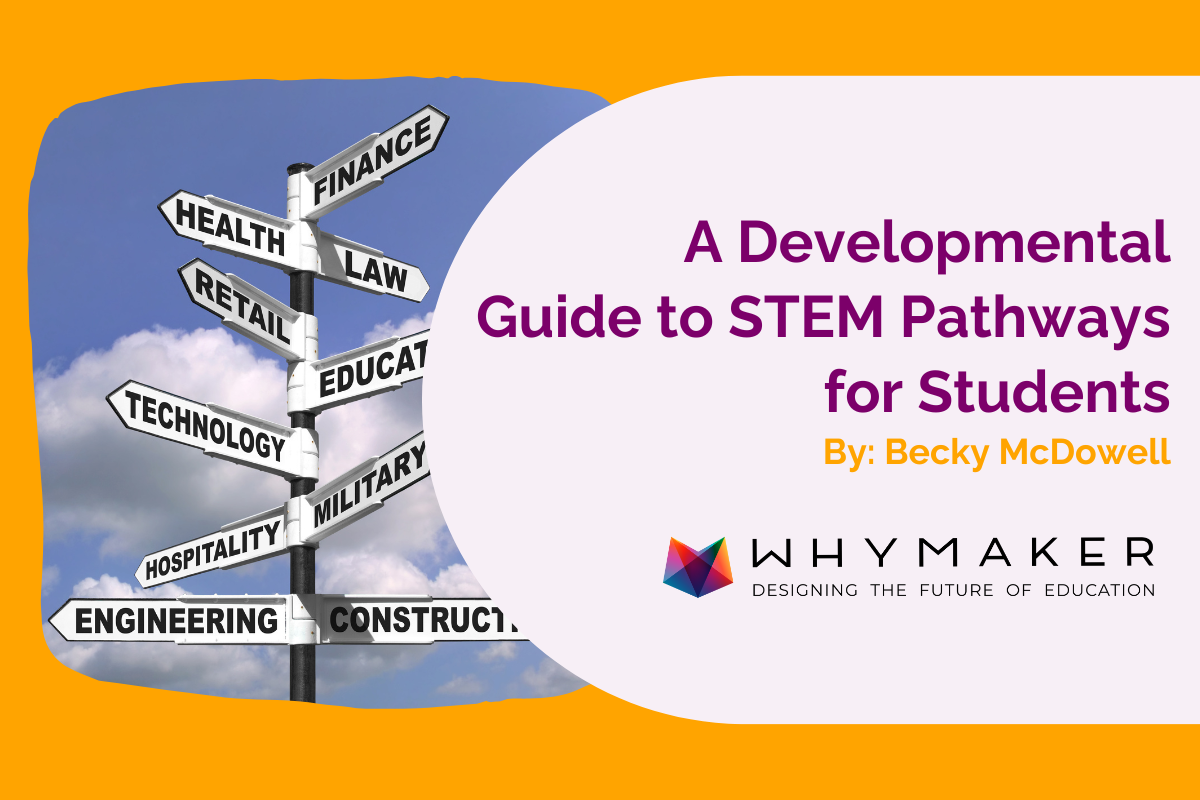The demand for STEM professionals is growing rapidly in a world increasingly driven by technology, artificial intelligence, and innovation. The Future of Jobs Report 2025 by the World Economic Forum suggests that “advancements in technologies, particularly AI and information processing (86%); robotics and automation (58%); and energy generation, storage and distribution (41%)” are expected to transform businesses and fuel the demand for technology-related skills. However, while the workforce is hungry for talent, the pathways for students to meet this demand are not as linear as we once thought.
The metaphor of a “leaky pipeline” was once used to describe the phenomenon of individuals gradually losing interest in pursuing STEM careers as they progress in their schooling. This pipeline view does not consider contextual factors and alternative pathways (Li, Kirk, & Oseguera, 2024). Instead, Li et. al. suggest adopting a pathway perspective that acknowledges personal agency and the influence of social cognitive factors and relationships.
Yet suppose we shift from viewing STEM careers as the end of a pipeline to understanding them as pathways shaped by identity, access, relationships, and exploration. In that case, one thing becomes clear: these journeys begin much earlier than high school. Students don’t typically wake up in 12th grade and suddenly choose to become engineers, data scientists, or energy analysts. Their interests, confidence, and perceptions of what’s possible are shaped by experiences and exposures that begin as early as elementary school.
The journey to a STEM career can be broken into three key developmental stages:
- Career Awareness (ages 5-10)
- Career Exploration (ages 11-14)
- Career Preparation & Readiness (ages 15+)
Let’s explore each stage, why it matters, and how educators, caregivers, and community partners can support students along the way.
Stage 1: Career Awareness (Elementary School, Ages 5-10)
Goal: Spark curiosity and broaden perceptions of who does STEM and what STEM careers look like.
Young children are natural scientists and engineers. They ask questions constantly, build structures out of whatever materials are nearby, and test how the world works. But unless we intentionally introduce them to STEM careers, they may never realize that this curiosity could lead to a satisfying career.
This is the age to plant seeds, not to ask, “What do you want to be when you grow up?” but “What problems do you want to solve?” and “Who do you want to help?”
Why It Matters:
- Children begin forming occupational preferences early as they engage in role play and are exposed to the careers of those they interact with the most frequently.
- Exposure at this stage builds identity. Kids begin to imagine, “Could I be a coder? A marine biologist? An inventor?”
- Without diverse role models, stereotypes around who belongs in STEM can take root early.
What It Looks Like:
- Read-alouds & storytelling: Books like Ada Twist, Scientist or Rosie Revere, Engineer introduce STEM through relatable, story-based characters
- Play-based learning: Simple robotics kits, building blocks, water tables, and tinkering stations encourage exploration and design thinking
- Guest speakers & career days: Invite community professionals such as software engineers, drone pilots, and conservationists to share what they do in a kid-friendly way
- Classroom posters & videos: Visual representations of STEM workers from diverse backgrounds normalize the idea that “anyone can do STEM”
How Adults Can Support:
- Use open-ended praise such as, “You solved a problem like an engineer!”
- Normalize mistakes and iteration as part of the learning process.
- Model curiosity and explore “how things work”
- Avoid gendered toys or comments that subtly discourage certain pathways (e.g., “You’re too creative to be an engineer!”)
Stage 2: Career Exploration (Middle School, Ages 11–14)
Goal: Provide hands-on experiences and scaffolded opportunities to try on roles, build skills, and learn about STEM pathways in greater depth.
Middle school is a pivotal age. Students are beginning to connect classroom learning to real-world applications. They’re asking, “Why does this matter?” and beginning to develop a sense of identity. This is when students either lean into STEM or quietly opt out.
Why It Matters:
- Research shows that most students have made decisions (consciously or not) that affect their future career paths by early adolescence (Gottfredson’s Theory of Circumscription, Compromise, and Self-Creation).
- Students begin selecting courses that can either open or close future STEM doors.
- Early exposure to STEM careers increases confidence and interest, particularly for students historically underrepresented in STEM.
What It Looks Like:
- Career-themed STEM units: Design challenges framed around real-world jobs (e.g., design a filtration system like an environmental engineer)
- Field trips and virtual job shadows: Visits to labs, field sites, tech companies, or maker spaces help students visualize workplaces. Videos such as CareerOneStop are a great alternative when field trips are not possible.
- STEM electives and clubs: Coding, robotics, science olympiads, environmental clubs, and design challenges give students identity-safe ways to explore
- Career interest inventories: Tools like the O*NET Interest Profiler help students begin to match their strengths to career clusters
- Mentoring opportunities: Partnering with local professionals or high school STEM students provides near-peer role models
How Adults Can Support:
- Reframe failure as part of the engineering design process.
- Help students see that STEM isn’t just about being “good at math or science,” it’s about solving problems, helping people, and making things better.
- Use media (like SciGirls or Mission Unstoppable) to show STEM in action.
- Encourage exploration over specialization. Middle school isn’t about picking a career, it’s about trying things on.
Stage 3: Career Preparation & Readiness (High School, Ages 15+)
Goal: Help students align interests with academic pathways, develop professional skills, and take tangible steps toward their future.
By high school, students are facing real choices—what classes to take, whether to pursue college or technical training, and what kind of work they want to contribute to the world. It’s not too late to ignite new interests, but the window for building a STEM-ready resume narrows.
Why It Matters:
- Students who take advanced STEM coursework in high school are more likely to pursue STEM majors in college and receive grants and other support crucial for continuing in those pathways.
- Internships and work-based learning build not just skills but confidence and networks.
- Career and Technical Education (CTE) programs can offer accelerated pathways to high-demand STEM fields without requiring a four-year degree.
What It Looks Like:
- Capstone projects: Students research, design, and present solutions to real-world challenges
- Dual enrollment or AP courses: Access to college-level math and science keeps doors open
- Internships or job shadowing: Real-world experience solidifies career interests (or helps rule them out)
- College and career fairs: Connect students with higher ed programs, scholarships, and employers
- Career interest inventories: Tools like the O*NET Interest Profiler help students match their strengths to career clusters, and the My Next Move website can provide detailed information about the skills and education needed along with the job outlook.
- CTE Pathways: Programs in biotechnology, engineering, health sciences, cybersecurity, and more offer both certification and a springboard to higher education
How Adults Can Support:
- Help students map career interests to post-secondary options (certifications, 2-year, 4-year, apprenticeships).
- Connect students to financial aid resources, scholarship opportunities, and apprenticeships.
- Build soft skills like communication, time management, and teamwork.
- Encourage students to reach out to professionals for informational interviews.
- Don’t assume all STEM careers require a four-year degree—many high-paying jobs are accessible through technical training or apprenticeships.
Why It All Matters: Closing the STEM Opportunity Gap
We often talk about the “STEM gap” as a problem of skills or knowledge, but it’s just as much about access and identity. Students can’t be what they can’t see. By aligning STEM career guidance with developmental readiness, we:
- Expand possibilities, especially for girls, students of color, and those from low-income communities
- Bridge classroom learning with future opportunities
- Build not just future workers, but future innovators, leaders, and change agents
The good news? You don’t need to be a scientist or engineer to make a difference. Teachers, parents, community leaders, and mentors all play vital roles in this journey.
Ten Actions You Can Take Today
- Read a STEM story aloud to a child and ask, “Would you want to do that?”
- Invite a guest speaker from your community to share how they use STEM.
- Host a “What’s That Job?” week in your school or after-school program.
- Introduce a design challenge based on a real-world problem.
- Start a STEM club where students can tinker, code, and create.
- Facilitate a career interest survey with your class.
- Watch a career video featuring diverse STEM professionals.
- Share your own career story—even if it isn’t in STEM.
- Connect students to internships or local CTE programs.
- Encourage curiosity, resilience, and a growth mindset.
Sources
Li, T., Kirk, C., & Oseguera, L. (2024). STEM Career as a Pathway: Stability and Dynamics of Students’ STEM Occupational Intention After High School. The Journal of Higher Education, 1–26. https://doi.org/10.1080/00221546.2024.2406734
World Economic Forum: https://www.weforum.org/publications/the-future-of-jobs-report-2025/digest/
Resources
CareerOneStop: https://www.careeronestop.org/Videos/CareerVideos/career-videos.aspx
Mission Unstoppable: https://www.youtube.com/channel/UCtgUyLVqgkbkVgVZTHMkECQ
My Next Move: https://www.mynextmove.org/
O*Net Interest Profiler: https://www.mynextmove.org/explore/ip
SciGirls: https://pbskids.org/scigirls/







